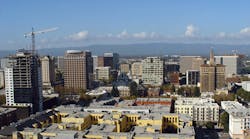Cities that have a concentration of highly-educated technology workers are attracting manufacturing companies. This in turn has led to the first increase in technology jobs in the U.S since 2001, according to new research by Jones Lang LaSalle.
The report, Perspectives on Technology Manufacturing, found that access to specialized expertise has started to outweigh the costs of real estate and labor as a site selection factor.
“This regionalization of high tech manufacturing trend is characterized by the creation of jobs requiring strong technological skills – think engineers on production lines – as opposed to re-shoring where similar job functions are imported back to the United States from overseas,” said Greg Matter, vice president at Jones Lang LaSalle.
“Having access to this talent is one of the reasons that manufacturing facilities for technology firms are often located in tier one locations where labor and real estate are generally more expensive,” Matter added.
Companies locating in the U.S. are driven by a series of factors:
- Protecting IP The need to protect intellectual capital in new product manufacturing is keeping the production of new tech products within the U.S. until the product is widely disseminated, at which time production costs can be reduced overseas.
- Co-location with engineers and executives Proximity of operations to executives, designers and engineers helps the product launch teams to perfect products during critical early-stage production.
- Consumer demand U.S. locations in some cases allow tech companies to respond more quickly to end- consumers’ requirements.
- Automation-savvy workers Highly automated manufacturing facilities don’t require a high volume of workers – but those hired must possess technical skills to operate highly complex systems.
Although the U.S. represents just 5% of the world’s population, it employs a third of global high-tech researchers and accounts for 40% of high-tech R&D, according to economist Richard Freeman.
Hot Markets for High-Tech Manufacturing Jobs
In 2010, about 79% of moderately high-tech manufacturing jobs, and 95% of very high-tech manufacturing jobs, were located in the 100 largest American metropolitan areas.Lower-level technology jobs are most concentrated in the southern states, while over a third of the most high-hech positions reside in companies on the West Coast.
The research indicates that between 2012 and 2018, high-tech manufacturing jobs are expected to proliferate further in California’s Silicon Valley –an even tighter real estate market as tech companies look for industrial space in addition to expanding their need for traditional office space as they grow.
Concentration of High-Tech Manufacturing
|
Location |
LQ (2012) |
Employment (2012) |
Employment (2018) |
Change |
|
San Jose, CA |
14.65 |
108,520 |
114,390 |
+ 5,870 |
|
Binghamton, NY |
8.06 |
7,110 |
7,050 |
- 60 |
|
Palm Bay, FL |
7.94 |
12,680 |
11,760 |
- 920 |
|
Durham, NC |
6.84 |
15,830 |
15,460 |
- 370 |
|
Manchester, NH |
6.63 |
10,760 |
10,120 |
- 640 |
|
Corvallis, OR |
5.94 |
1,880 |
1,900 |
+ 20 |
|
Boulder, CO |
5.75 |
7,920 |
8,070 |
+ 150 |
Another attractive market is Austin, Texas, already a mushrooming technology hub, now also becoming a magnet for high-tech manufacturing growth. The area is well-known as a tech hub, and offers a well-established presence of manufacturing and R&D operations in the metro area that take advantage of the thousands of graduates in engineering and computer science the University of Texas generates each year. An survery by Forbes ranked Austin among the top five U.S. cities for job prospects in 2013.
Additional high-tech opportunities are located in Los Angeles, CA; Binghamton, New York; Portland, Oregon; Boulder, Colorado; Phoenix, Arizona; Boston, Massachusetts and Boise, Idaho.
A second tier of smaller but growing high-tech clusters are scattered across the U.S., but expanding most rapidly in the southeastern states where companies are taking advantage of the low cost of living and less expensive, yet skilled, labor force.
Other North American cities will also compete with American hubs as important technology manufacturing centers, such as Toronto to the north and Guadalajara, Juarez and Tijuana to the south.



